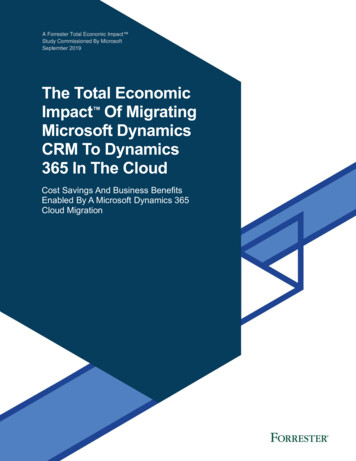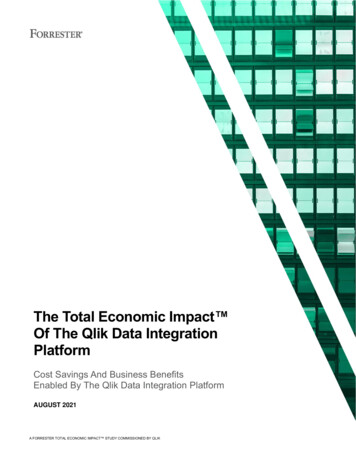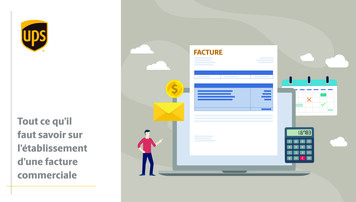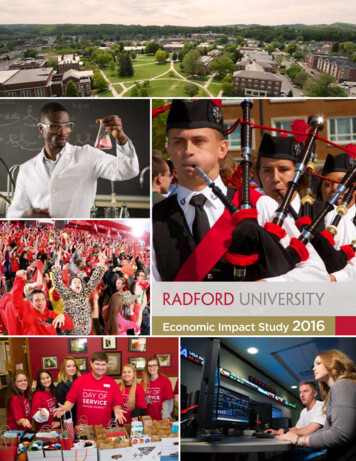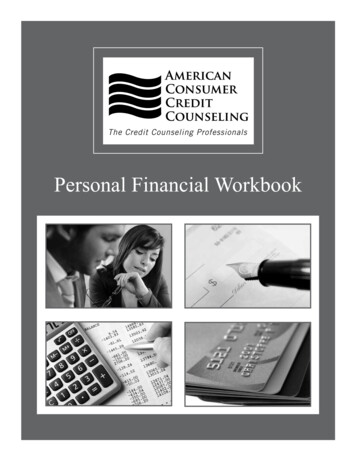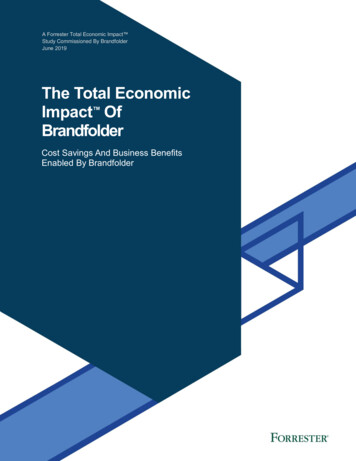
Transcription
A Forrester Total Economic Impact Study Commissioned By BrandfolderJune 2019The Total EconomicImpact OfBrandfolderCost Savings And Business BenefitsEnabled By Brandfolder
Table Of ContentsExecutive SummaryKey Findings11TEI Framework And Methodology4The Brandfolder Customer JourneyInterviewed Organization55Key Challenges5Why Brandfolder6Key Results7Analysis Of BenefitsEfficiency Gains For RMDs And Creative TeamContent Distribution Cost Savings11Campaign Activity Savings12Better And Faster Customer Service14Annual Savings Related To Retiring Legacy Solution16Topline Impact – Utilizing Brandfolder To Rebrand16Unquantified Benefits17Flexibility18Analysis Of CostsBrandfolder Onboarding And Licensing FeesImplementation And Training CostsFinancial SummaryBrandfolder: OverviewAppendix A: Total Economic ImpactAppendix B: Supplemental MaterialAppendix C: EndnotesProject Director:Nick Ferrif991919202122242525ABOUT FORRESTER CONSULTINGForrester Consulting provides independent and objective research-basedconsulting to help leaders succeed in their organizations. Ranging in scope from ashort strategy session to custom projects, Forrester’s Consulting services connectyou directly with research analysts who apply expert insight to your specificbusiness challenges. For more information, visit forrester.com/consulting. 2019, Forrester Research, Inc. All rights reserved. Unauthorized reproductionis strictly prohibited. Information is based on best available resources.Opinions reflect judgment at the time and are subject to change. Forrester ,Technographics , Forrester Wave, RoleView, TechRadar, and Total EconomicImpact are trademarks of Forrester Research, Inc. All other trademarks are theproperty of their respective companies. For additional information, go toforrester.com.
Executive SummaryBrandfolder provides a digital asset management (DAM) platform thathelps its customers organize, manage, distribute, and analyze brandassets. Moreover, Brandfolder’s proprietary machine learning (ML) andartificial intelligence (AI) technologies empower global brand leaders withcritical data and actionable insights, better informing their creative strategyand development. Brandfolder commissioned Forrester Consulting toconduct a Total Economic Impact (TEI) study and examine the potentialROI enterprises may realize by deploying Brandfolder. The purpose of thisstudy is to provide readers with a framework to evaluate the potentialfinancial impact of Brandfolder on their organizations.Benefits And CostsEfficiency gains related toenforcement of brand standards: 387,250To better understand the benefits, costs, and risks associated with thisinvestment, Forrester interviewed a current customer with experienceusing Brandfolder. The interviewed organization uses Brandfolder toefficiently distribute approved brand assets to more than 4,000 retaillocations across the globe. Brandfolder enables the core creative andmarketing team to seamlessly distribute brand assets and content tothousands of distributed stakeholders from a single platform.Prior to using Brandfolder, the interviewed customer utilized an alternativedigital asset management solution with limited success. The organizationfound that the prior solution was difficult to use, limited in its capabilities,and not capable of international distribution or access. With this priorsolution, the process for distributing new content to the relevantstakeholders was unreliable and labor intensive. Regional marketingdirectors would receive the approved assets and were tasked withdistributing them to the franchisees and agencies in their market.Distributing assets meant emailing a link to an online storage provider andhoping that the recipient: 1) received the email; 2) successfullydownloaded the new assets; 3) updated their existing collateral with thenewly approved assets; and 4) deleted the old and no longer approved ofbrand assets so they are not accidentally reused in the future. As a resultof the shortcomings of the previous platform, the interviewed organizationsaw a divergence of brand consistency between the international anddomestic (US) franchisees.Content distribution cost savings: 270,222Campaign activity savings: 63,391Key FindingsQuantified benefits. The interviewed organization experienced thefollowing risk-adjusted present value (PV) quantified benefits:› Efficiency gains for regional marketing directors and creative teamtotaling 378,250. Regional marketing directors were able to save4 hours per week in review and enforcement activities, sinceBrandfolder’s intuitive platform guaranteed accuracy of content.Additionally, the creative team was able to save 2 hours per week bydistributing preapproved templates for the creation of localizedfranchisee-level content.1 The Total Economic Impact Of Brandfolder
ROI260%› Content distribution cost savings of 270,222. The head of contentsaves 5 hours per week by eliminating ad hoc content requests, whileinternational regional marketing directors experience a 12% boost inproductivity. Franchisees were no longer reaching out to the head ofcontent with ad hoc requests for specific assets. Meanwhile,international regional marketing directors now distributed collateralthrough the Brandfolder platform, eliminating manual workflowspreviously used to distribute and monitor use of content.Benefits PV 1.2 million› Improvement in campaign management created 63,391 inefficiency gains. The time it took to kick off a campaign was reduced bymore than 90%, from four days with the previous solution to less than 1hour with Brandfolder. Managing campaigns became 10% more efficientthrough the use of Brandfolder’s insights and data reporting capabilities.NPV 854,133› Improved customer service and support represents 128,145 insavings. Brandfolder provides more customer service channels, fasterremediation times, and better overall support for the interviewedorganization. Additionally, the self-service knowledge base effectivelydeflected many service requests away from internal resources.Payback 3 months› Savings related to retiring the legacy asset library solution totaled 179,053. After implementing Brandfolder, the interviewed organizationterminated their legacy solution annual license.› Rebranding with Brandfolder represented 163,636 in additionalbenefits. The ability to instantly push updated brand assets and logos toall 4,000 global locations guaranteed that every franchise has the mostup-to-date brand assets. Additionally, because all 4,000 franchises haveaccess, corporate can feel confident that any old assets or logos will notbe accidently posted because they are no longer available for downloadfrom the Brandfolder platform.Unquantified benefits. The interviewed organization experienced thefollowing benefits, which are not quantified for this study:› Greater brand consistency and control. All assets that are uploadedto Brandfolder have been vetted and approved by the marketing andcreative team and any old assets are removed. This ensures that endusers only have access to approved assets, and significantly reducesthe possibility for a franchisee or agency to post an incorrect or out-ofdate asset.› Ability for local franchisees to customize content for their market.Brandfolder’s intuitive platform, user permissions, and controlled accesscapabilities gave the interviewed organization the confidence to pushresponsibility for local market branding out to the regional marketingdirectors who have the best understanding of what will resonate in theirmarkets. According to Forrester research, producing content thatresonates at a local level, especially for international brands, can have asignificant positive impact on sales and customer retention.1› Efficiency gains for franchisees. This study primarily focuses on thebenefits to the core creative and marketing team at the interviewedorganization, but it is important to note that the more than 4,000franchisees and agencies can now leverage Brandfolder to findapproved assets and also realize similar benefits. These benefits includeefficiency gains for finding content and increased sales by more easilyparticipating in corporate campaigns and having greater control overlocal content.Costs. The interviewed organization experienced the following
risk-adjusted PV costs:› Onboarding and licensing fees total 282,119 over three years.Brandfolder required a 20,000 initial onboarding fee and 100,000annual licensing and services fee.› Implementation and training expenses total 46,445. Costs arerepresented by a four-week implementation period and 1.5 hours oftraining per employee.Forrester’s interview with an existing customer and subsequent financialanalysis found that the interviewed organization experienced benefits of 1.2 million over three years versus costs of 328,564, adding up to a netpresent value (NPV) of 854,133 and an ROI of 260%.Impact from rebrand with Brandfolder, 163,636Annual savings relatedto legacy DAM solution, 179,053Efficiency gains for RMDs andcreative team, 378,250 1.2 millionthree-year totalbenefits PVBetter and faster customerservice, 128,145Campaign activity savings, 63,391Content distributioncost savings, 270,222
TEI Framework And MethodologyFrom the information provided in the interview, Forrester has constructed aTotal Economic Impact (TEI) framework for those organizationsconsidering implementing Brandfolder.The objective of the framework is to identify the cost, benefit, flexibility, andrisk factors that affect the investment decision. Forrester took a multistepapproach to evaluate the impact that Brandfolder can have on anorganization:The TEI methodologyhelps companiesdemonstrate, justify,and realize thetangible value of ITinitiatives to bothsenior managementand other keybusinessstakeholders.DUE DILIGENCEInterviewed Brandfolder stakeholders and Forrester analysts to gatherdata relative to Brandfolder.CUSTOMER INTERVIEWInterviewed one organization using Brandfolder to obtain data withrespect to costs, benefits, and risks.FINANCIAL MODEL FRAMEWORKConstructed a financial model representative of the interview using theTEI methodology and risk-adjusted the financial model based on issuesand concerns of the interviewed organization.CASE STUDYEmployed four fundamental elements of TEI in modeling BrandfolderBrandfolder’s impact: benefits, costs, flexibility, and risks. Given theincreasing sophistication that enterprises have regarding ROI analysesrelated to IT investments, Forrester’s TEI methodology serves to provide acomplete picture of the total economic impact of purchase decisions.Please see Appendix A for additional information on the TEI methodology.DISCLOSURESReaders should be aware of the following:This study is commissioned by Brandfolder and delivered by ForresterConsulting. It is not meant to be used as a competitive analysis.Forrester makes no assumptions as to the potential ROI that otherorganizations will receive. Forrester strongly advises that readers use their ownestimates within the framework provided in the report to determine theappropriateness of an investment in Brandfolder.Brandfolder reviewed and provided feedback to Forrester, but Forrestermaintains editorial control over the study and its findings and does not acceptchanges to the study that contradict Forrester’s findings or obscure themeaning of the study.Brandfolder provided the customer names for the interviews but did notparticipate in the interviews.
The Brandfolder Customer JourneyBEFORE AND AFTER THE BRANDFOLDER INVESTMENTInterviewed OrganizationFor this study, Forrester interviewed a Brandfolder customer with thefollowing characteristics:› It is a global quick service restaurant (QSR) food brand.› 4,000 locations, a majority of which are franchisees.› 15,000 total employees, including franchisees.› 1.5B annual revenue.› 13 regional marketing directors (RMDs) and 30 administrators.The interviewed organization is a global QSR brand with over 4,000franchises across North America, South America, Europe, Asia, NorthAfrica and the Middle East. The organization was growing frustrated withthe limited capabilities of their previous solution, including a lack ofinternational functionality, and evaluated multiple potential replacementsbefore settling on Brandfolder.The organization has 13 RMDs distributed across the world, eachresponsible for managing their local market. The creative team consistsof 7 designers, one copywriter, and a traffic coordinator. They areoverseen by a creative director who reports to the chief marketing officer.The organization leverages user permissions to control what users areallowed to do in Brandfolder, granting “Guest” access to franchisees (canonly view/download assets) and “Collaborator” access to agencies (canupload, edit, view, and download assets). In addition to userpermissions, the organization is also able to control, on a very granularlevel, what specific assets each franchise has access to based on theirregion and what campaigns the franchise is participating in. Additionally,it is a simple matter to modify and update these permissions.Key ChallengesBefore the investment in Brandfolder, the interviewed organizationdescribed the following challenges with their previous solution:› Lack of international functionality. The previous solution was onlyavailable in the US, which meant international RMDs had different andmore labor-intensive processes for accessing and distributing brandassets. The interviewed organization noted, “My whole mantra fromday one was that it has got to work in a small city in China, forexample, where the franchisee speaks limited English and needs tofind the right asset without help from their RMD or the corporate office.”Additionally, because of the lack of international functionality, theinterviewed organization found it difficult to keep a consistent brandmessage across markets while still resonating on a local level. Theorganization needed to give local franchisees more power and controlover the content that they used. The interviewee noted that, “Prior toBrandfolder there was an international organization and a domesticorganization; they had the same logo, but there was not a lot of“My whole mantra from day onewas that it has got to work in asmall city in China, forexample, where the franchiseespeaks limited English andneeds to find the right assetwithout help from their RMD orthe corporate office.”Head of content, QSR
flexibility when there needed to be, as far as how brand guidelineswere interpreted depending on the local culture.”› Poor user interface and user experience led to loweredproductivity and increased ad hoc content requests. Theinterviewed organization described a dated interface, unreliablecommunication from the previous vendor, and general difficulty infinding the assets that people were looking for. The head of contentexplained: “It was a library, but the infrastructure was very dated.Updates were never communicated on time. And people couldn’t findthings. I think that was the biggest issue, it just wasn’t user-friendly.”› Inconsistent and unsophisticated customer support. The previousvendor was only reachable via email, had inconsistent response times,and lacked the sense of urgency and understanding that is expected ofan enterprise-level technology vendor. The head of content wasfrustrated with the lack of consistency. When a colleague asked howlong until they could expect a resolution to an issue, he consistentlyhad to respond with, “I’ve notified the vendor of the problem, andhopefully we should hear back from them soon.”Why BrandfolderThe interviewed organization selected Brandfolder because:› International functionality, data-driven sorting, and user-levelpermissions. The interviewed organization was able to grantBrandfolder access to all employees, franchisees, and agencies thatneeded it across the globe. With user-level permissions, theorganization could control what assets each stakeholder can access,ensuring franchisees had access to the correct assets while givingagencies and in-house designers the freedom to create and updateexisting content. Additionally, with data-driven sorting, it was easy forfranchisees to zero in on the exact asset, in the correct format, thatthey were looking for, without reaching out to corporate for assistance.› Easy and intuitive platform. Brandfolder is an intuitive platform thatallows users to quickly find the assets that they are looking for. Withfeatures such as intelligent search and advanced filters, both US andinternational users are able to find the right asset at the right time. Thedirector of content explained that, “It’s an easier platform to not onlywork in, but also for people initially jumping in and thinking, ‘Oh, okay,this makes sense.’”› Great customer support and reliability with Brandfolder.Brandfolder guarantees 99.99% availability over a given year.2 It offersrobust customer support, including access to their developer team tohelp solve any technical or infrastructure issues.3 The interviewedorganization noted: “The customer support has been fantastic, actually.We’ve had a few little hiccups here and there, as expected with anynew solution, but the fact that Brandfolder jumped on it and got theresolution in the time that they did is fantastic.”“They have a support featurethat’s really nice. It’s got theLive Chat feature, it’s gotemail support, and it’s got aknowledge base for people.This platform is so easy to usethat if you’ve got a question,go to the knowledge base firstand you’re more than likely tofind the answers.”Head of content, QSR
Key ResultsThe interview revealed that key results from the Brandfolder investmentinclude:› Shift accountability and control of content to local markets. Theinterviewed organization has been able to give local franchisees morecontrol over the content that they leverage which, in turn, has shiftedthe onus to update with relevant content away from the corporate officeand on to the local franchisees. This was a welcome change for localfranchisees, who know what resonates in their local market, and for thecorporate office, who is no longer responsible for managing the uniquechallenges of every international market from afar.“That’s one of the cool thingsabout Brandfolder, it enablesthis autonomy andaccountability without givingup control over the core brandassets.”Head of content, QSRThe head of content discussed the shift in strategy: “We’ve giveneverybody in other countries the responsibility to manage their ownmarkets. It’s not my responsibility to translate assets for your marketand all that. It’s your market, we’ve provided the assets and the tools,it’s up to you to develop your own materials and manage your ownpeople. That’s one of the cool things about Brandfolder, it enables thisautonomy and accountability without giving up control over the corebrand assets.”› More efficient campaign management. User-level permissions,smart sorting, and Brandfolder event and usage data have significantlyreduced the time and manual effort involved with kicking off andmanaging campaigns for the interviewed organization. The head ofcontent walked through the process with using Brandfolder: “I wouldsay the biggest gain is the ability to manage a campaign. For example,we have a new campaign kicking off and are working with an agency.I’ve created a Brandfolder for that campaign with sections for thedifferent medias, I’ve given that agency access to Brandfolder andhave granted them permission to upload assets to it. Then we invitethe franchisees that are going to participate in this campaign, and theycan access all of the content and leverage the assets as they needthem. It’s as simple as that.”Additionally, the data and insights that Brandfolder provides haveenabled RMDs to be more efficient and effective in how they managetheir markets. The head of content went on to say, “And then, once thecampaign is over, or even going through the active campaigns, we cango through the Brand Intelligence feature and find out who is using theassets and when and why and where. It helps the RMDs get a betteridea of the people they manage. And it is easier to manage theirmarkets that way with that information. So that has been a hugeasset.”› Improved relationship with franchisees. Brandfolder’s intuitive userinterface and ease of use has created a level of appreciation betweenthe franchisees and the corporate office. The interviewed organizationis able to demonstrate to its franchisees that corporate is investing innext-generation tools for franchisees and is committed to making themas successful as possible. The head of content explained: “I think userinterface is huge. For one, when we invite a franchisee to use theplatform the franchisee feels like, ‘Hey, I have access to all this stuffand it’s easy to get to, it’s easy to use.’ So there is an appreciation that,‘Hey, you’ve included me in on this. I have the keys to a small city. Ihave some responsibility and I can get these assets if I need them.’”“I didn’t know it would go assmooth and be so wellreceived when we firstlaunched. Until the first twocampaigns wrapped and I waslike, wow, I think we’re reallyon to something withBrandfolder.”Head of content, QSR
› Better control over brand content with significantly reduced timeand effort associated with pushing out new assets, especiallyduring a rebrand. The interviewed organization found that withBrandfolder, the manual processes that were once necessary todistribute new content to RMDs and franchisees were eliminated,freeing up time to focus on revenue-driving activities. Additionally,moving away from the legacy manual processes has significantlyimproved corporate control over brand consistency. The head ofcontent noted: “With Brandfolder, it’s a single click and I can send outnew assets. If I’m updating an old asset, Brandfolder will automaticallyreplace the old asset with the updated version so it is automaticallyavailable next time a franchisee logs in. They just love it, it’s great.”After implementing Brandfolder, the interviewed organizationexperienced an urgent need to quickly update brand assets across theglobe and push out a new logo for all franchisees to adopt. WithBrandfolder, they were confident that when the organization said “go,”the newly updated assets would be available to all 4,000 franchiseessimultaneously. The head of content described their approach: “Thislogo is going to be approved, so let’s get it uploaded to Brandfolderand put it in a pending state, so when we distribute it, we can just clicka button and everybody has got it.”“And that’s the good thing about Brandfolder, whatever is on there is approved and everything is locked down.We control who has access to each asset and who can add or delete assets. For example, our franchiseescan’t delete anything, all they can do is download assets. It’s not up to me and my team to police anymore.Head of content, QSR
Analysis Of BenefitsQUANTIFIED BENEFIT DATATotal BenefitsREF.BENEFITYEAR 1YEAR 2YEAR 3TOTALPRESENTVALUEAtrEfficiency gains for RMDs and creative team 152,100 152,100 152,100 456,300 378,250BtrContent distribution cost savings 108,660 108,660 108,660 325,981 270,222CtrCampaign activity savings 25,490 25,490 25,490 76,471 63,391DtrBetter and faster customer service 51,529 51,529 51,529 154,587 128,145EtrAnnual savings related to legacy DAM solution 72,000 72,000 72,000 216,000 179,053FtrTopline impact: utilizing Brandfolder to rebrand 180,000 0 0 180,000 163,636Total benefits (risk-adjusted) 589,780 409,780 409,780 1,409,339 1,182,697Efficiency Gains For RMDs And Creative TeamThe interviewed organization described efficiency gains for RMDs andthe internal creative team related to Brandfolder’s intuitive userexperience as well as the use of Brandfolder’s templating feature toreduce effort associated with creating localized assets.› RMDs can more easily monitor their markets and regulatefranchisee content. Brandfolder is the single source of truth for allbrand assets — this guarantees that franchisees are only using themost recently approved brand assets when they create localizedcontent, reducing the time RMDs spend on monitoring andenforcement.Previously, when a RMD noticed an incorrect asset in their market, itwould take one to two weeks of back-and-forth communications withthe franchise to correct the issue with the proper asset. WithBrandfolder, franchisees no longer have access to incorrect assets,and if an old asset is somehow published, the updated version isalready available in Brandfolder at the click of a button.› Templates give flexibility to local markets while reducing workfor corporate creative team. By leveraging Brandfolder’s templatingfeature, the interviewed organization’s creative team is able to reducethe total number of assets that they create, freeing up time to focus onnew campaigns and ideas. Additionally, the templates empower localfranchisees to create their own, on-brand content that is relevant totheir market.These benefits can be achieved through a variety of Brandfolderfeatures, including, templates, collections, smart search, auto format andconversion resizing, user permissions, and insights and analytics to helpRMDs monitor their local franchisees.Based on the customer interview, Forrester estimates:› 13 RMDs and 7 designers on the creative team.The table above shows the total of allbenefits across the areas listed below,as well as present values (PVs)discounted at 10%. Over three years,the interviewed organization expectsrisk-adjusted total benefits to have aPV of 1.2 million.RMDs save 4 hours perweek on review andenforcement tasks.
› 10% time savings for RMDs on review and enforcement of brandassets — this translates into 4 hours per week of time savings.› 2 hours per week saved for each designer due to the availability ofpreapproved templates for franchisees and agencies to leverage.› An average fully burdened RMD salary of 108,000 per year.› An average fully burdened designer salary of 81,000 per year.This benefit can vary due to uncertainty related to:› RMD and designer salaries — note that salary is a conservativeestimate of the value an employee provides to the organization.› Size of management and creative teams.› Adoption of templates for franchisees.To account for these risks, Forrester adjusted this benefit downward by10%, yielding an annual risk-adjusted total PV of 152,100.Impact risk is the risk that the businessor technology needs of theorganization may not be met by theinvestment, resulting in lower overalltotal benefits. The greater theuncertainty, the wider the potentialrange of outcomes for benefitestimates.Efficiency Gains For RMDs And Creative Team: Calculation TableREF.METRICCALC.YEAR 1YEAR 2YEAR 3A1Number of RMDsComposite131313A2Time saved on review/enforcement of brand assets from localfranchises (hours/week)Interview444A3Average RMD salary, fully burdened (hourly)Industry 52 52 52A4Subtotal: RMD, review and enforcement efficiencies(A1*A2*A3)*52 140,608 140,608 140,608A5Number of designers on creative teamComposite777A6Average creative team member salary,fully burdened (hourly)Industry 39 39 39A7Time saved through franchise and agency use of templates tocreate custom content (hours/week)Interview222A8Subtotal: creative team time savings from use of templates –composite organization(A5*A6*A7)*52 28,392 28,392 28,392AtEfficiency gains for RMDs and creative teamA4 A8 169,000 169,000 169,000Risk adjustment 10% 152,100 152,100 152,100AtrEfficiency gains for RMDs and creative team (risk-adjusted)
Content Distribution Cost SavingsThe interviewed organization described efficiency gains related todistributing approved content to franchisees and agencies. Additionally,Brandfolder works internationally, so international RMDs now haveaccess to the same platform as their US-based counterparts, creatingadditional efficiencies.› Eliminated ad hoc content requests from franchisees. Theinterviewed organization reported that after implementing Brandfolder,the head of marketing and his team no longer received ad hocrequests for specific content from franchisees and other stakeholdersbecause everything was readily available in Brandfolder.› International functionality creates efficiency gains forinternational RMDs. With Brandfolder, RMDs were given an entirelynew toolset to manage the franchisees in their region. Features likeuser-level permissions and Brandfolder’s data and insights capabilitiesgave RMDs a holistic view of how assets were being leveraged in theirmarket and subsequently allowed them to focus their energy on valueadded tasks, rather than on the enforcement of brand standards.Based on the customer interview, Forrester estimates:› Head of content saves 1 hour per day from no longer fielding ad hocrequests for content.› There are 8 international RMDs.› International RMDs save an average of 4.8 hours per week withBrandfolder in place.› An average fully burdened salary for the head of content is 135,000.› An average fully burdened salary for a RMD is 108,000.This benefit can vary due to uncertainty related to:› Head of content and RMD salaries — note that salary is a conservativeestimate of the value an employee provides to the organization.› Volume of ad hoc content requests prior to Brandfolder adoption.› Manual effort involved with distributing and monitoring content prior toBrandfolder.To account for these risks, Forrester adjusted this benefit downward by10%, yielding an annual risk-adjusted total PV of 108,660.Organizations save5 hours per weekwith fewer ad hoccontent requests.
Content Distribution Cost Savings: Calculation TableREF.METRICCALC.YEAR 1YEAR 2YEAR 3B1Time spent fielding ad hoc asset requests (hours per week)Composite555B2Annual head of content salary,fully burdened (hourly)Industry 65 65 65B3Subtotal: cost savings – fielding ad hoc content requestsB1*B2*52 16,900 16,900 16,900
digital asset management solution with limited success. The organization found that the prior solution was difficult to use, limited in its capabilities, and not capable of international distribution or access. With this prior solution, the process for distributing new content to the relevant stakeholders was unreliable and labor intensive.



